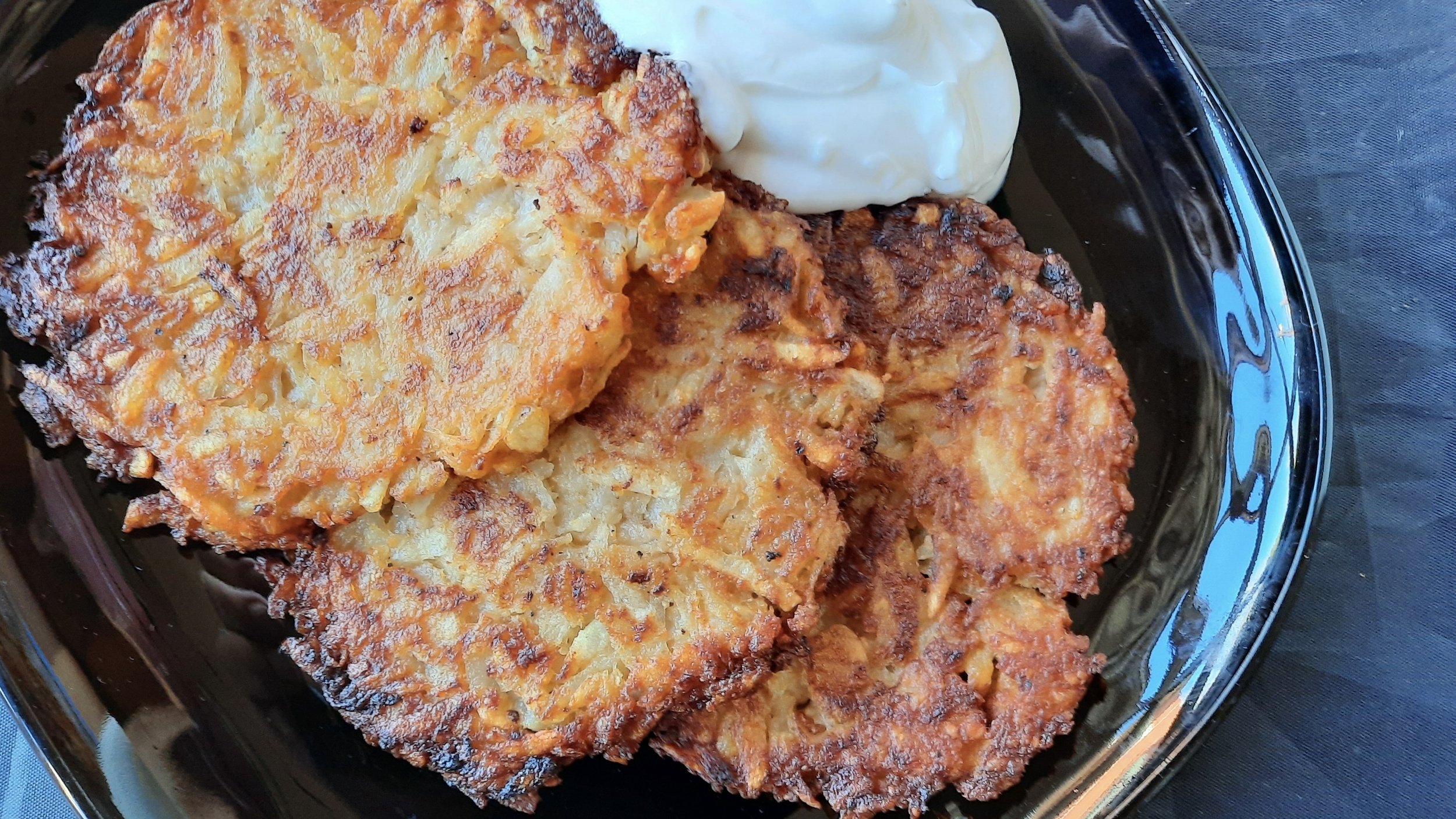LEFTOVERS AND LATKES
RECIPES: Leftovers and Latkes
Makes 6-8, depending on size.
Ingredients
2 medium- to medium-large russet potatoes, peeled
1/4 cup white or yellow onion, chopped
3/4 cup cooked leftover white or sweet potatoes
1/2 teaspoon kosher or fine sea salt
A few grinds white pepper, to taste
1/4 cup matzo meal
1 large egg, whisked in a small bowl
Canola or other neutral oil for frying
Sour cream or plain yogurt
Directions
After peeling the potatoes and before proceeding to grate them, be sure the whole potatoes are soaking in cold water. (For example, you may peel them ahead and keep them in the refrigerator covered in water.) When ready to cook, set up a wire cooling rack over a brown paper bag set in a baking tray near the heat source.
Place the onion, leftover potatoes, salt and pepper and matzo meal in the bowl of a food processor at the ready.
Pat the potatoes dry and grate them on the large holes of a box grater. (If they are particularly moist, squeeze handfuls of them of excess liquid.) Proceed quickly with the remainder of the recipe so that the grated potatoes do not oxidize (turning grey or red-brown).
Over medium-high heat, warm a heavy-bottomed skillet (cast-iron or stainless steel are best for browning) and into it pour 1/4-1/3 inches of oil. Begin heating the oil until it shimmers. Pulse the contents of the food processor 7-8 times; do not purée the mixture. In a large bowl, add the contents of the processor bowl to the grated potatoes. Add the egg and fold in everything well, but do not overwork.
Scoop 1/2-cup portions of the latke mix and gently lay them into the hot oil. With a spatula, flatten each into a patty no more than 1/2-inch thick. Do not crowd the pan; you will cook more than one batch. Fry until the edges begin to brown, 3-4 minutes. Flip and fry for another 3-4 minutes. It may be helpful to use two spatulas to flip or move the latkes.
Watch the temperature of the oil: too hot and the edges will darken before the middles cook through. Too low and the latkes will become soggy with fat. Also, you may find it helpful to wipe off the back of the spatula, from time to time, on paper towels.
Serve with sour cream or whipped yogurt.
Another latke recipe is here; it is Zaidy’s Deli’s Gerard Rudofky’s, which he has allowed me to share. Also, read up on the Jewish feast of Hanukkah and also the centrality of oil in the cooking of the Jews. Fascinating, both.
Wine Pairings and Why: Odd as it seems, sweet foods are the most difficult to pair with wine. Sweetness, as one or more sugars such as fructose or sucrose, combines with the majority of wines (themselves dry) to cause sensations on the tongue of bitterness, astringency and acidity. Drink a dry white Burgundy with vanilla ice cream and discover a terrible experience. But if you pair the level of sugar in the food with a corresponding (or slightly higher) level of sweetness in the wine, that works. A good example is pairing an apple tart with a medium-sweet muscat. But the overall guideline is that sweetness in food requires the same level of sweetness in wine. With some moderately sweet desserts, that wine would be a Moscato from Italy or this country or a Piedmontese Brachetto d’Acqui. With very sweet desserts, a Port, or a Bordeaux Sauternes, or even a Bual or Malmsey Madeira from Portugal.
